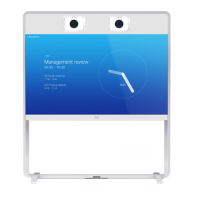Note that updates may take a few minutes to be displayed in the status table.
Other status information available includes:
Field Description
NTP server The actual NTP server that has responded to the request. This may be different to the NTP server
in the NTP server address field.
Condition Gives a relative ranking of each NTP server. All servers that are providing accurate time are
given a status of Candidate; of those, the server that the VCS considers to be providing the most
accurate time and is therefore using shows a status of sys.peer.
Flash A code giving information about the server's status. 00 ok means there are no issues. See the
Flash status word reference table [p.493] for a complete list of codes.
Authentication Indicates the status of the current authentication method. One of ok, bad or none. none is
specified when the Authentication method is Disabled.
Event Shows the last event as determined by NTP (for example reachable or sys.peer)
Reachability Indicates the results of the 8 most recent contact attempts between the VCS and the NTP server,
with a tick indicating success and a cross indicating failure. The result of the most recent attempt
is shown on the far right.
Each time the NTP configuration is changed, the NTP client is restarted and the Reachability
field will revert to all crosses apart from the far right indicator which will show the result of the first
connection attempt after the restart. However, the NTP server may have remained contactable
during the restart process.
Offset The difference between the NTP server's time and the VCS's time.
Delay The network delay between the NTP server and the VCS.
Stratum The degree of separation between the VCS and a reference clock. 1 indicates that the NTP
server is a reference clock.
Ref ID A code identifying the reference clock.
Ref time The last time that the NTP server communicated with the reference clock.
For definitions of the remaining fields on this page, and for further information about NTP, see Network Time
Protocol website.
VCS time display and time zone
Local time is used throughout the web interface. It is shown in the system information bar at the bottom of the
screen and is used to set the timestamp that appears at the start of each line in the Event Log.
Note that UTC timestamps are included at the end of each entry in the Event Log.
Internally, the VCS maintains its system time in UTC. It is based on the VCS's operating system time, which
is synchronized using an NTP server if one is configured. If no NTP servers are configured, the VCS uses its
own operating system time to determine the time and date.
Specifying your local Time zone lets the VCS determine the local time where the system is located. It does
this by offsetting UTC time by the number of hours (or fractions of hours) associated with the selected time
zone. It also adjusts the local time to account for summer time (also known as daylight saving time) when
appropriate.
Cisco VCS Administrator Guide (X8.1.1) Page 46 of 507
Network and system settings
Network services

